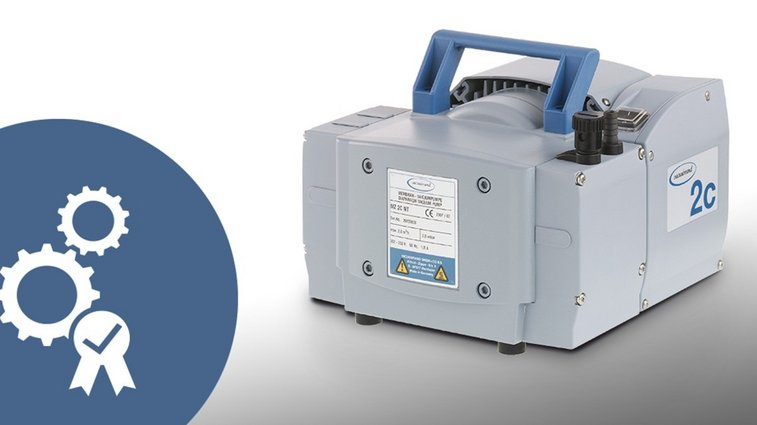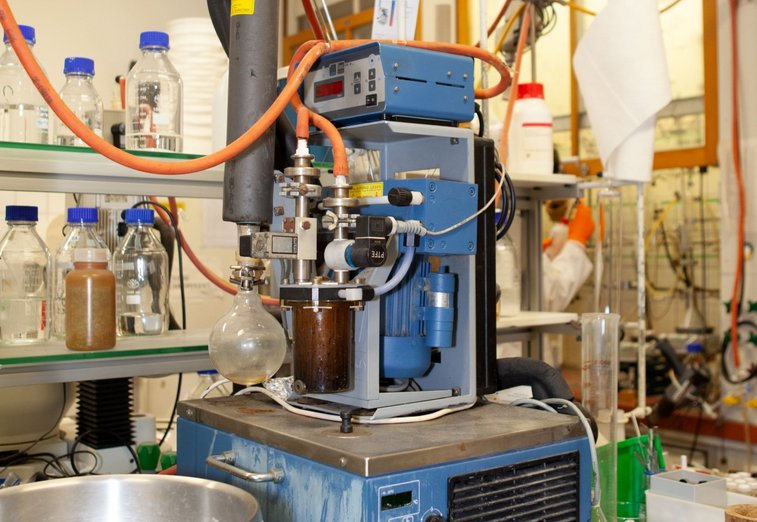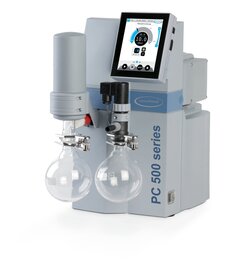
The MZ 2C chemistry diaphragm pump stands for quality and durability.
The MZ 2C vacuum pump has been around since 1982 and was the first chemistry diaphragm pump on the market for laboratory use. Since then, we have continuously improved it and further developed new products based on its unique design. To this day, the MZ 2C NT product line is a prime example of quality and durability in vacuum pumps.
"The MZ 2C chemistry diaphragm pump was in use at one of our customers for almost 40 years," says Francesco de Luca di Roseto of DELTEK SRL, VACUUBRAND sales and service partner in Italy. It is a real workhorse in the laboratory. The MZ 2C is considered a classic among diaphragm pumps: the compact pump size is ideal for laboratory scale. With its pumping speed of up to 2.0 m3/h at 50 Hz (2.3 m3/h at 60 Hz) and an ultimate vacuum of 7 mbar, it is suitable for many different applications. For example, the MZ 2C is used for rotary evaporators, vacuum drying ovens and vacuum concentrators.
The MZ 2C was the first chemically resistant diaphragm pump launched to the market in 1982. Its chemical resistance marked a breakthrough of diaphragm pump technology in the laboratory. Prior to this, processes involving aggressive gases or vapors were only possible with conventional pumps, which entailed some limitations and disadvantages: Rotary vane pumps were and are very maintenance-intensive, as they require oil as an operating medium for lubrication and sealing. In addition, a cold trap with liquid nitrogen or dry ice is needed to protect the pump from chemicals on the inlet side. Water jet pumps, on the other hand, consume an enormous amount of fresh drinking water and additionally pollute the wastewater with chemicals and solvents. The new MZ 2C chemistry diaphragm pump was therefore a technological milestone in terms of innovation, efficiency and sustainability in the laboratory: it was chemically resistant even without a cold trap and required neither water nor oil as an operating medium.
Robust and durable chemistry diaphragm pump
What made the MZ 2C chemistry vacuum pump special? "Right from the start, the design was conceived to be particularly robust and durable. To achieve this, we relied on completely new material combinations in the development of the MZ 2C," explains Dr. Barbara Richarz, Head of Product Management at VACUUBRAND.
Different chemically resistant fluoroplastics with high long-term stability and density are used for the wetted components in the pump head – such as the diaphragm, head cover, clamping disk and valves. Then as now, the MZ 2C diaphragm pumps are therefore reliable companions in the laboratory, withstanding even aggressive gases and vapors over a long period of time. Depending on the application, experience has shown that they have maintenance intervals in the range of 15,000 operating hours or longer, as well as an overall service life of many years.
The MZ 2C chemistry diaphragm pump was in use at one of our customers – the University of Naples Federico II – for almost 40 years at the Faculty of Chemistry.
Industry trends – from the basic pump to the regulated pumping station
Always on the lookout for further benefits for users, we have set new trends with the constant further development of and additions to the original MZ 2C basic pump. We owe our innovations over the decades primarily to the valuable exchange of experience with our customers.

This early chemically resistant pumping station from VACUUBRAND was put into operation in the early 1990s. It still provides a strong, reliable vacuum in a chemistry research lab today – despite the harshest of conditions.
One remaining challenge in the laboratory, for example, was that although solvents were no longer released into wastewater, they were still released into the exhaust air or even into the laboratory atmosphere. So how could laboratory users capture and dispose of their solvent vapors in a controlled manner at the point of generation? Our solution to this was the emission condenser on the outlet side of the vacuum pump. All solvents that enter the pump in the vapor phase are thus condensed at the pump outlet at atmospheric pressure and collected for safe disposal or reuse. This was the birth of VACUUBRAND's first vacuum pumping station (formerly PC 5).

Today's chemically resistant pumping units of the PC 500 select product series from VACUUBRAND have interactive vacuum controllers with predefined vacuum processes for all common laboratory applications. In the case of solvent evaporation, the controller automatically detects the boiling pressure.
From then on, we continued to develop the pumping stations and equipped them with interactive controllers for vacuum control. Today's devices such as the PC 510 select make it possible to simply select the connected laboratory application via an intuitive user interface and use it to start the pump and control mode. The controller then automatically guides the vacuum process as far as possible towards completion.
Another requirement of many of our customers was to use two rotary evaporators simultaneously in one fume hood. This left no more room for two additional diaphragm pumps. For us, it was the starting signal for the MZ 2C SYNCHRO, a diaphragm pump with two suction connections for parallel operation of two processes and a common outlet – integrated check valves at the inlets prevent mutual interference here.
With the latest series "NT – New Technology", our present MZ 2C NT was finally created. The performance of the vacuum pump was further improved by an optimized drive concept. What does this mean for users? Better ultimate vacuum and higher suction power, which lead to even shorter process times. This is an important advantage, in many applications, such as drying processes where very high steam loads occur.
Wide range of products based on the MZ 2C
The robust and durable MZ 2C has been offered by VACUUBRAND for almost four decades. We have adopted its features as the technological basis for a complete diaphragm pump series. These chemistry vacuum pumps vary in sizes and performance data in terms of ultimate vacuum and pumping speed to meet as many different process requirements as possible. The selection ranges from simple basic pumps to vacuum systems with emission condenser and condensate collecting flask to complete pumping units with electronic vacuum control and solvent recovery. In addition, such pumping stations are available with two individual connections for parallel operation. What are your requirements for a laboratory vacuum pump?
Do you also have an elderly, reliable diaphragm pump from VACUUBRAND in use? Show us your MZ 2C.
